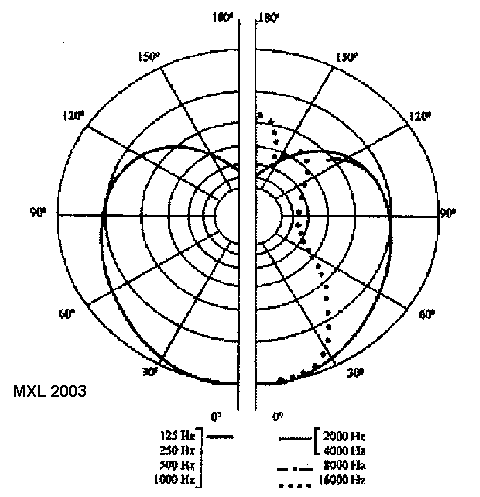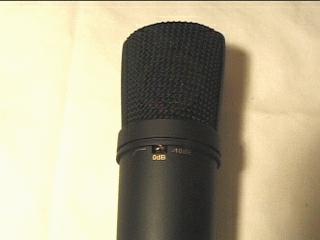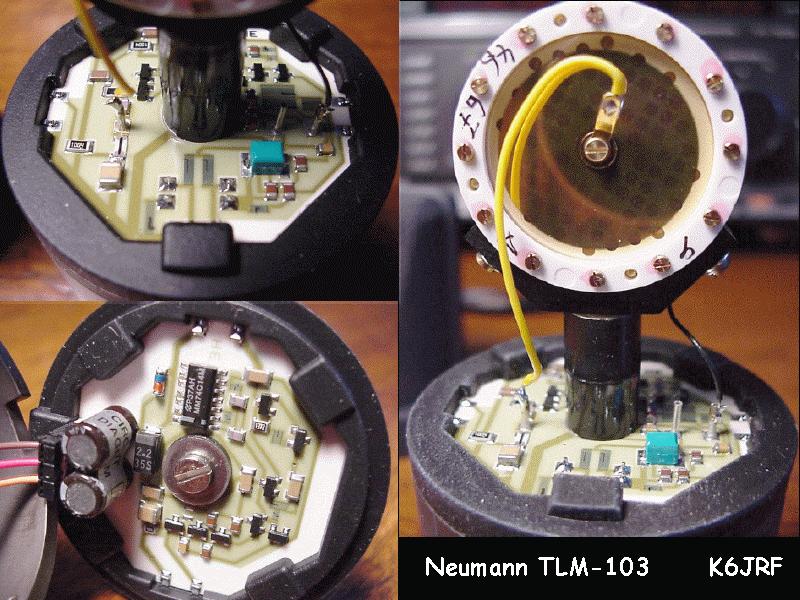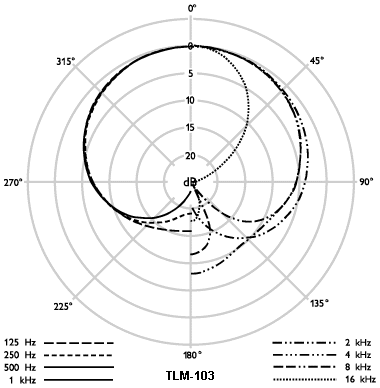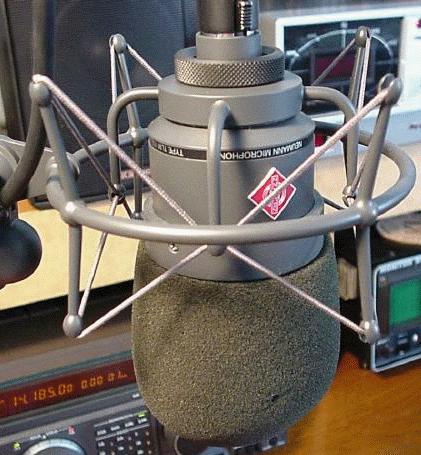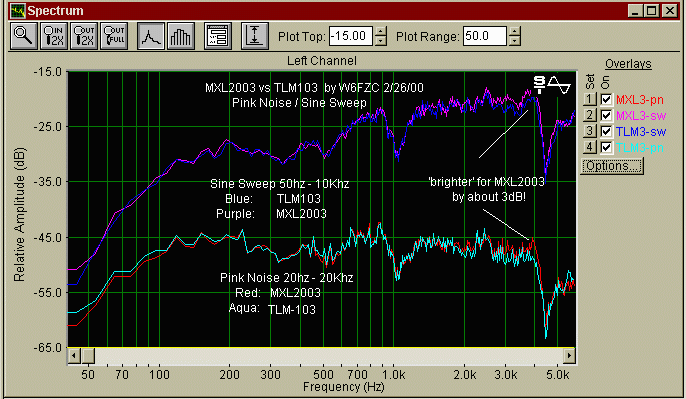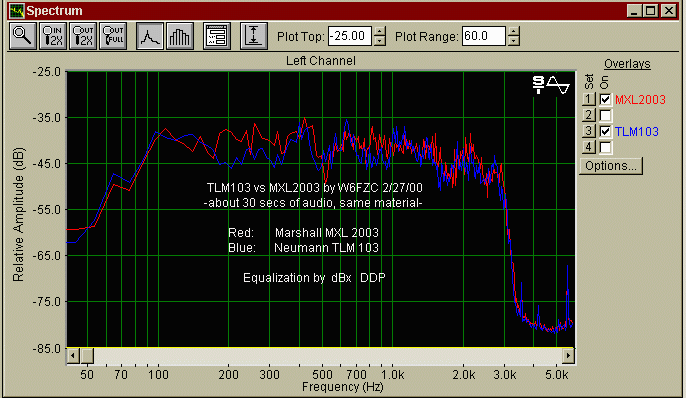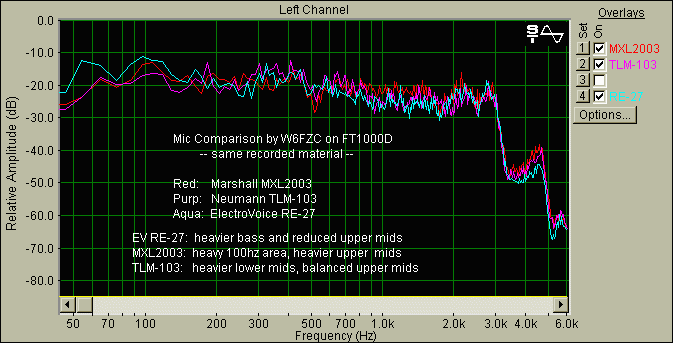|
K6JRF's Page |
|
This Mic Comparison Page summarizes the test results of two popular large diameter
condenser microphones; Marshall MXL2003, Neumann TLM-103 and ElectroVoice RE27.
Various frequency, polar and spectral plots using SpectraPlus are included. Some of the charts in this report are no
longer available! |
|
Background I started with a dynamic mic, the Electro Voice RE27. When the Marshall microphone line was introduced, I purchased the MXL2003. It sounds good and the price is reasonable, but, I wondered, is there anything better? Neumann in Germany, started in the early 1940's was then called Telefunken and were the 'standard' of the industry. The U47 was known as the 'Telly' and it was reported that Frank Sinatra wouldn't sing without his 'Telly'. Since Neumann mics have always had a reputation for quality and a sonic 'mystic', I just had to try one. Marshall MXL-2003 The MXL2003 was introduced by Marshall Electronics last year and it was an immediate sensation! For the list price of $399 including shockmount, everyone could now afford a quality condenser mic for their studio. Smaller studios could now produce quality sound for their work. The MXL2003 is intended for the most critical recording applications where tremendous clarity, presence and detail are required. Ideal for recording classical to jazz and rock to rap, the MXL2003 is an outstanding performer in a class with the worlds finest studio mics. Its 1.06 inch capsule is coupled through an electromagnetic screen to a FET preamp with a wideband transformerless output. Comes complete with a high isolation shock mount.
Neumann TLM-103 The Neumann TLM 103 is the ideal large diaphragm microphone for all professional and semi-professional applications requiring the utmost in sound quality on a limited budget. However with a price tag around $1170 including shockmount, it makes it more difficult to afford than the MXL2003. The letters TLM stands for 'TransformerLess Microphone'. With TLM technology the usual output transformer is replaced by an electronic circuit. As with traditional transformers, it ensures good common mode rejection, and prevents RF interference that may influence the balanced audio signal. By utilizing the tried and true transformerless circuit found in numerous Neumann microphones, the TLM103 features yet unattained low self-noise and the highest sound pressure level transmission. The capsule, derived from that used in the U87, has a cardioid pattern, is acoustically well-balanced and provides extraordinary attenuation of signals from the rear. The TLM 103 is available in satin nickel and matte black. Delivery includes an SG 103 swivel mount and a wooden jeweler's box. The shockmount is not included. It prices out around $200. The TLM 103 is addressed from the front, marked with the red Neumann logo on the microphone body. The K103 large diaphragm capsule is based on the K87, well known from the U67/U87 microphones. The capsule has a flat frequency response up to about 4Khz, and above that, a wide flat 4 dB presence boost.
Audio Sweeps: The MXL2003 and TLM103 were swept by audio signals. Each mic was swept using pink noise (PN) and sinewave (SW) from 50hz to 5Khz. The PN source is full bandwidth, 20hz to 20Khz but only 50hz to 6Khz is displayed. The equipment used in the setup was; Preamp, Aphex 107 Tubessence; PN and SS source, Sony MD MZ-R55; Power Amp, Technics SU-Z25 (30W/chan @ 0.03% dist); Charts, SpectraPlus running on my laptop SENS-810. Analysis charts are plotted using SpectraPlus (SP). I use SP in conjunction with a laptop and/or minidisk to form a mobile alignment and test tool. The use of pink noise results in a time saving, accurate method of aligning any signal path assuring a flat frequency response. Note that only 50hz to 6Khz info is displayed.
1) The MXL2003 mic is a little 'brighter' from 3Khz on (about +3db). 2) The TLM103 mic is a little 'heavier' from 50hz to 100hz (about +1dB). But the overwhelming results show that BOTH MICS ARE ALMOST IDENTICAL! This makes the decision much easier on which mike to buy! Based on the price ($399 vs $1170), there's really not much question, is there? Voice Tests: The attached chart shows results of audio tests with the two mics reading the same material to produce about 30 secs of audio from yours truly's voice. Each mic was equalized to present the 'best' sound (this is very relative!) possible and recorded via from the calibrated FT1000D phone jack into the Sony Minidisk MZ-R55 (20hz to 20Khz). Then the recordings were 'played' back into SP and a spectrum plot of each recorded.
ON-THE-AIR Tests: The real proof any microphones performance comes with on-air testing. Let's not change that fact. The tests for all mics consisted in using a standard paragraph that has good frequency balance. All mics were equalized with the same settings on my audio equipment; the Aphex 104, 250, and dBx DDP. I also was able to test a ElectroVoice RE27 dynamic mic at this point in the test, so I've included the results for comparison with the two condenser mics. The spectral patterns are very similar but at the same time different! The RE27 has the heaviest bottom end, reduced mid frequency area, and brightest highs. The MXL2003 has a heavy 100hz area and brighter upper mid range response. The TLM103 has a smoother low frequency response and with balanced upper mid frequencies.
The MXL2003 is a great sounding mic when price ($399 list) and performance is considered. One drawback is the lack of quality and consistency from unit to unit, so you better audition a few to be sure (this one is surely a great one!). If you hear one that sounds 'good', then snap it up! The TLM103 does not suffer from quality and consistency from unit to unit but at the list price of $1170, this is not a drop-in-the-bucket for small studios and Hams on a budget. But if great clean, articulate sounds with no coloration are paramount, then the TLM103 is the choice for you. The EV RE27 (list price of $790) is another great choice with the added feature of no phantom voltage requirement. The sound is well balanced and the mic's construction is top notch. Any of these mics will perform well for you. |
|
Send me |
